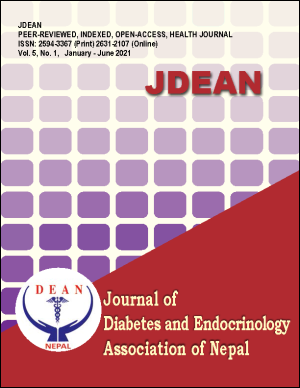Comparison of IDRS and ADA Diabetes Risk Assessment Tools Reveals Different Rsk Score in Same Population: A Cross-Sectional Analysis in a Tertiary Care Hospital
DOI:
https://doi.org/10.3126/jdean.v5i1.38799Keywords:
Diabetes Risk Assessment Score, IDRS, ADA Diabetes Risk aassessment toolAbstract
Background: To identify individuals at high risk of developing type2 diabetes (T2DM), use of a validated risk-assessment tool is currently recommended. Nevertheless, recent studies have shown that risk scores that are developed in the same country can lead to different results of an individual. The Objective of study was to reveal whether two different risk-assessment tools predict similar or dissimilar high-risk score in same population.
Method: This cross-sectional analytical study was carried upon 336 non-diabetic adults visiting the outpatient department (OPD) of Medicine, MARKS Medical College & Hospital, Bangladesh from October 2018 to March 2019. Woman having previous history of Gestational Diabetes Mellitus (GDM) were also included. Both the Indian Diabetes risk Score (IDRS) and the American Diabetes (ADA) Risk Score questionnaire were used to collect the data on demographic and clinical characteristics, different risk factors of an individual subject, and to calculate predicted risk score for developing T2DM.
Results: Among 336 subjects, 53.6% were female. The mean (±SD) age of the study subjects was 38.25±1.12 years. The average IDRS predicted risk score of developing T2DM was more in female subjects than male [p<0.05]. Whereas the ADA predicted increased risk score of developing type 2 diabetes was more in male subjects than female (p<0.05). IDRS categorized 37.2 % of individuals at high risk for developing diabetes; [p=0.10], while the ADA risk tool categorized 20.2% subjects in high risk group; [p<0.001].
Conclusions: The results indicate that risk for developing type 2 diabetes varies considerably according to the scoring system used. To adequately prevent T2DM, risk scoring systems must be validated for each population considered.
Downloads
Downloads
Published
How to Cite
Issue
Section
License
Copyright (c) 2021 N. Akter, N.K. Qureshi

This work is licensed under a Creative Commons Attribution-NonCommercial 4.0 International License.
This license enables reusers to distribute, remix, adapt, and build upon the material in any medium or format for non-commercial purposes only, and only so long as attribution is given to the creator.




